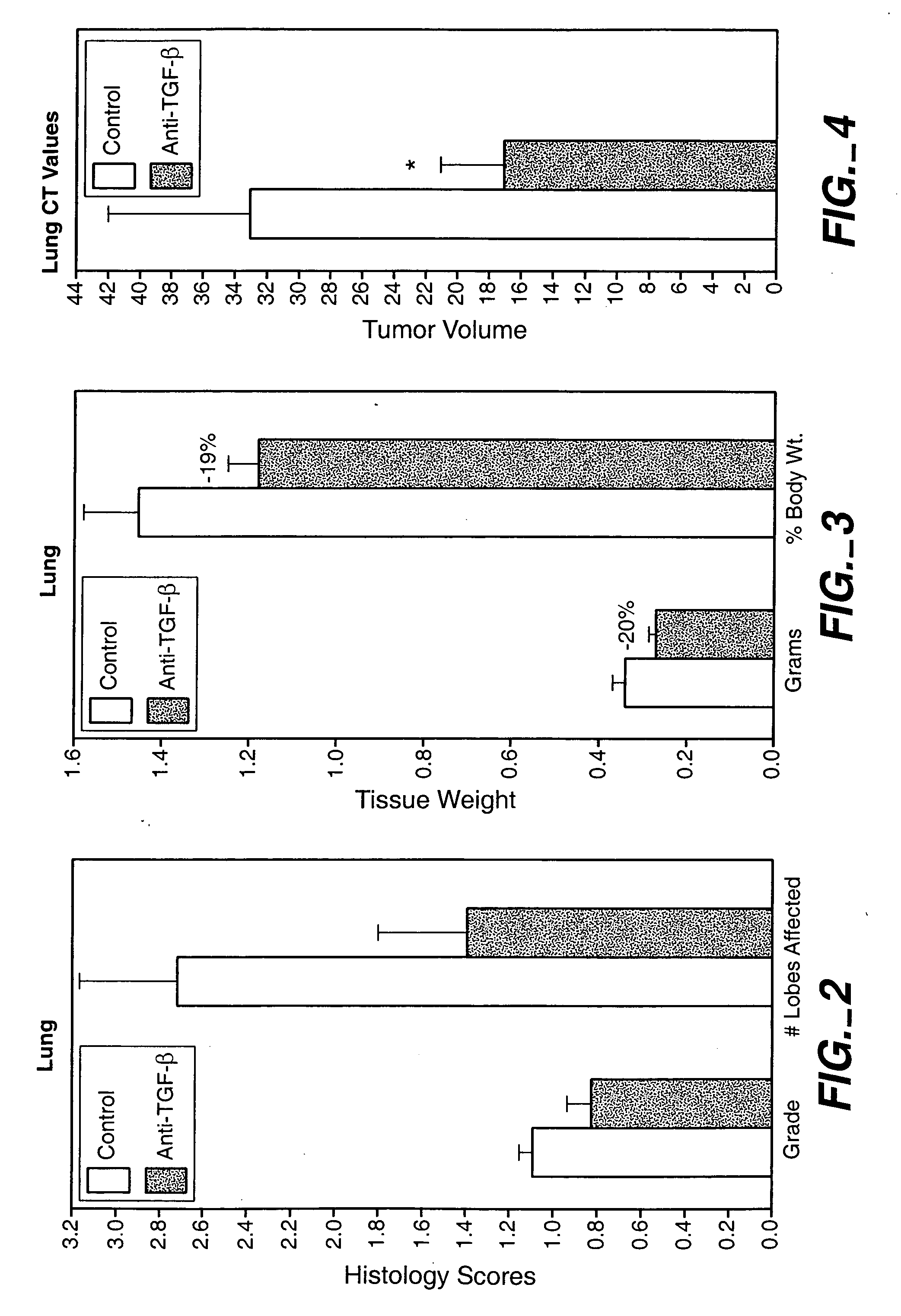Screening assays and methods of tumor treatment
a tumor and assay technology, applied in the field of tumor tumor treatment candidate molecules, can solve the problems of difficult to eradicate and treat, difficult to achieve the effect of eradication and treatment, and almost invariably detrimental disruptions in the normal physiology of cell division
- Summary
- Abstract
- Description
- Claims
- Application Information
AI Technical Summary
Benefits of technology
Problems solved by technology
Method used
Image
Examples
example 1
Production and Characterization of Monoclonal Antibodies 2G7 and 4A11
A. Assay Procedures
I. ELISA Determination
[0259] 96-well polystyrene assay plates were coated with 100 μl / well of purified TGF-beta1 at 1 μg / ml in pH 9.6 carbonate buffer for 18 hours at 4° C. Coated plates were blocked with 0.5% bovine serum albumin (BSA) in phosphate-buffered saline (PBS) (called BPBS) for one hour at 22° C., washed with 0.05% TWEEN2™ in PBS (called PBST), and incubated with 100 μl of hybridoma supernatants for one hour at 22° C. Plates were washed with PBST, and bound antibodies were detected with a goat anti-mouse IgG conjugated with peroxidase (Tago, Burlingame, Calif.). The plates were washed with PBST, and o-phenylenediamine dihydrochloride substrate was added at 100 μl / well. The reaction was stopped after 15 minutes and the optical density at 492 nm was determined on a UVMAX™ plate reader (Molecular Devices, Palo Alto, Calif.).
II. Iodination of rTGF-beta1
[0260] Purified TGF-beta1 was...
example 2
Humanized 2G7 Antibodies
[0278] The variable domains of murine monoclonal antibody 2G7 were first cloned into a vector that allows production of a mouse / human chimeric Fab fragment. Total RNA was isolated from the hybridoma cells using a STRATAGENE™ RNA extraction kit following manufacturer's protocols. The variable domains were amplified by RT-PCR, gel purified, and inserted into a derivative of a pUC119-based plasmid containing a human kappa constant domain and human CH1 domain as previously described (Carter et al,. Proc. Natl. Acad. Sci. (USA), 89: 4285 (1992) and U.S. Pat. No. 5,821,337). The resultant plasmid was transformed into E. coli strain 16C9 for expression of the Fab fragment. Growth of cultures, induction of protein expression, and purification of Fab fragment were as previously described (Werther et al,. J. Immunol., 157: 4986-4995 (1996); Presta et al., Cancer Research, 57: 4593-4599 (1997)).
[0279] DNA sequencing of the chimeric clone allowed identification of the ...
example 3
Study of Tumor Metastasis in Mouse Models of Metastatic Breast Cancer
A. 4T1 Model
[0293] In a first set of experiments, 4T1 cells were derived from a single spontaneously arising mammary tumor from a BALB / cfC3H mouse. Primary 4T1 tumor cells were injected into mammary fat pads of immunocompetent BALB / c mice One week after injection, palpable primary tumors were observed. The tumor spontaneously metastasized into the lung (about two week after injection), liver and spleen (about three weeks after injection) and bone (between about 4 and 5 weeks after injection).
[0294] The animals were treated with 15 mg / kg, 25 mg / kg and 43 mg / kg doses of an anti-TGF-β antibody (2G7). Tests were carried out at day 0, 1, 2, and 1 and 2 weeks after injection of cancer cells. As shown in FIG. 1, treatment with a 43-mg / kg dose transiently decreased the size of primary tumor, and reduced systemic levels of VEGF. The 25-mg / kg dose was found to provide better results than the 15-mg / kg dose, while there wa...
PUM
| Property | Measurement | Unit |
|---|---|---|
| concentration | aaaaa | aaaaa |
| temperature | aaaaa | aaaaa |
| temperature | aaaaa | aaaaa |
Abstract
Description
Claims
Application Information
 Login to View More
Login to View More - R&D
- Intellectual Property
- Life Sciences
- Materials
- Tech Scout
- Unparalleled Data Quality
- Higher Quality Content
- 60% Fewer Hallucinations
Browse by: Latest US Patents, China's latest patents, Technical Efficacy Thesaurus, Application Domain, Technology Topic, Popular Technical Reports.
© 2025 PatSnap. All rights reserved.Legal|Privacy policy|Modern Slavery Act Transparency Statement|Sitemap|About US| Contact US: help@patsnap.com



